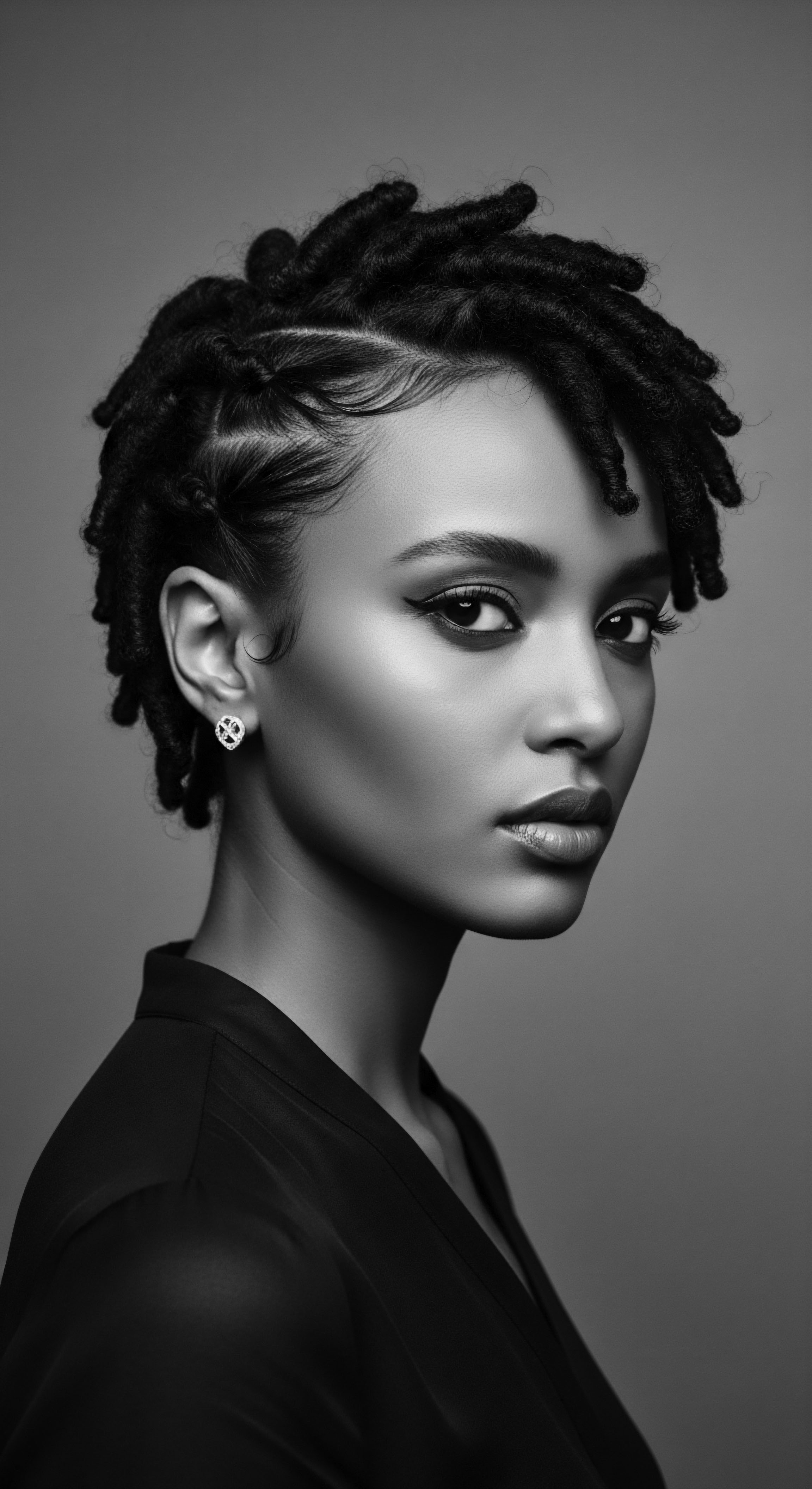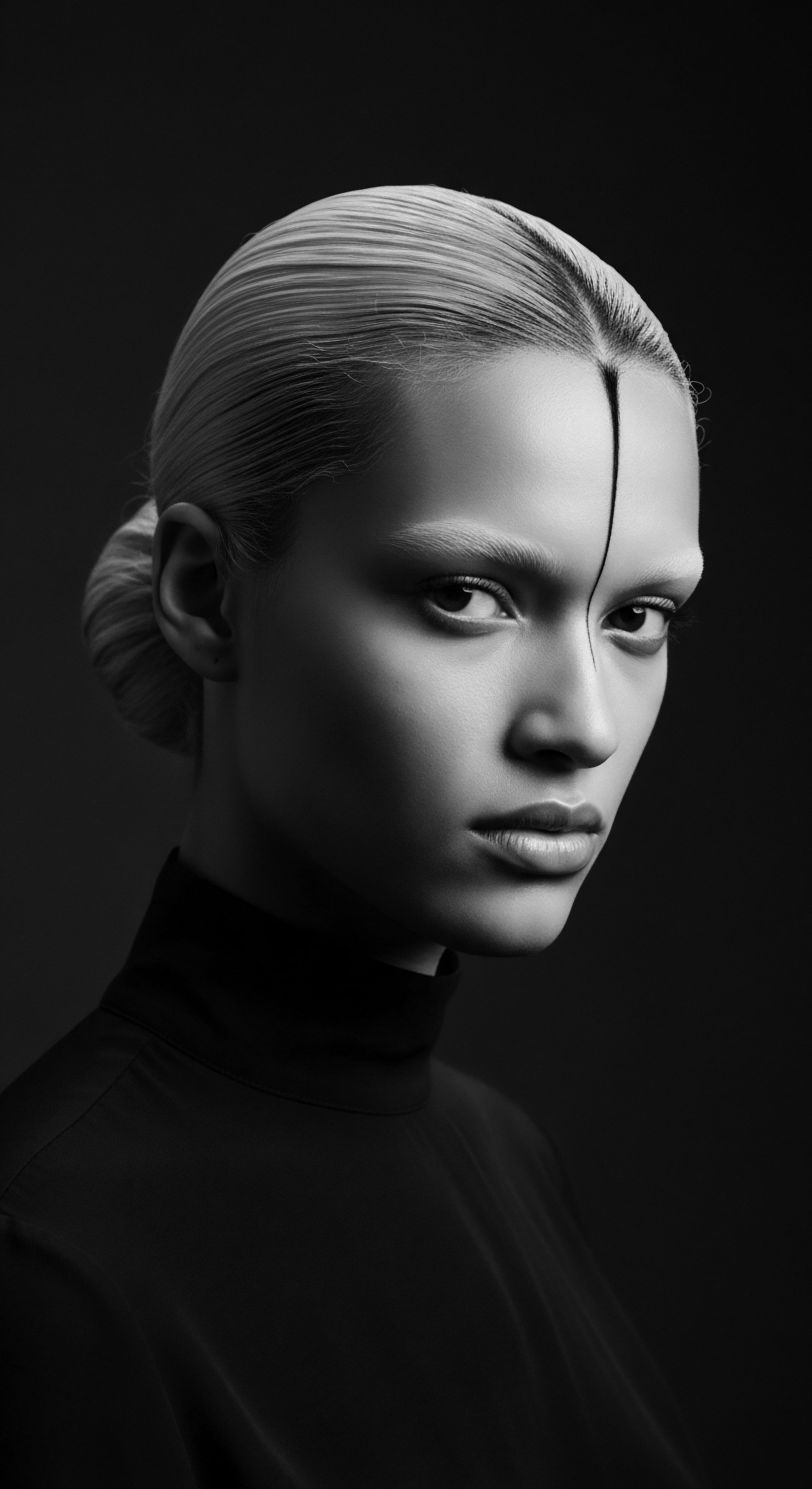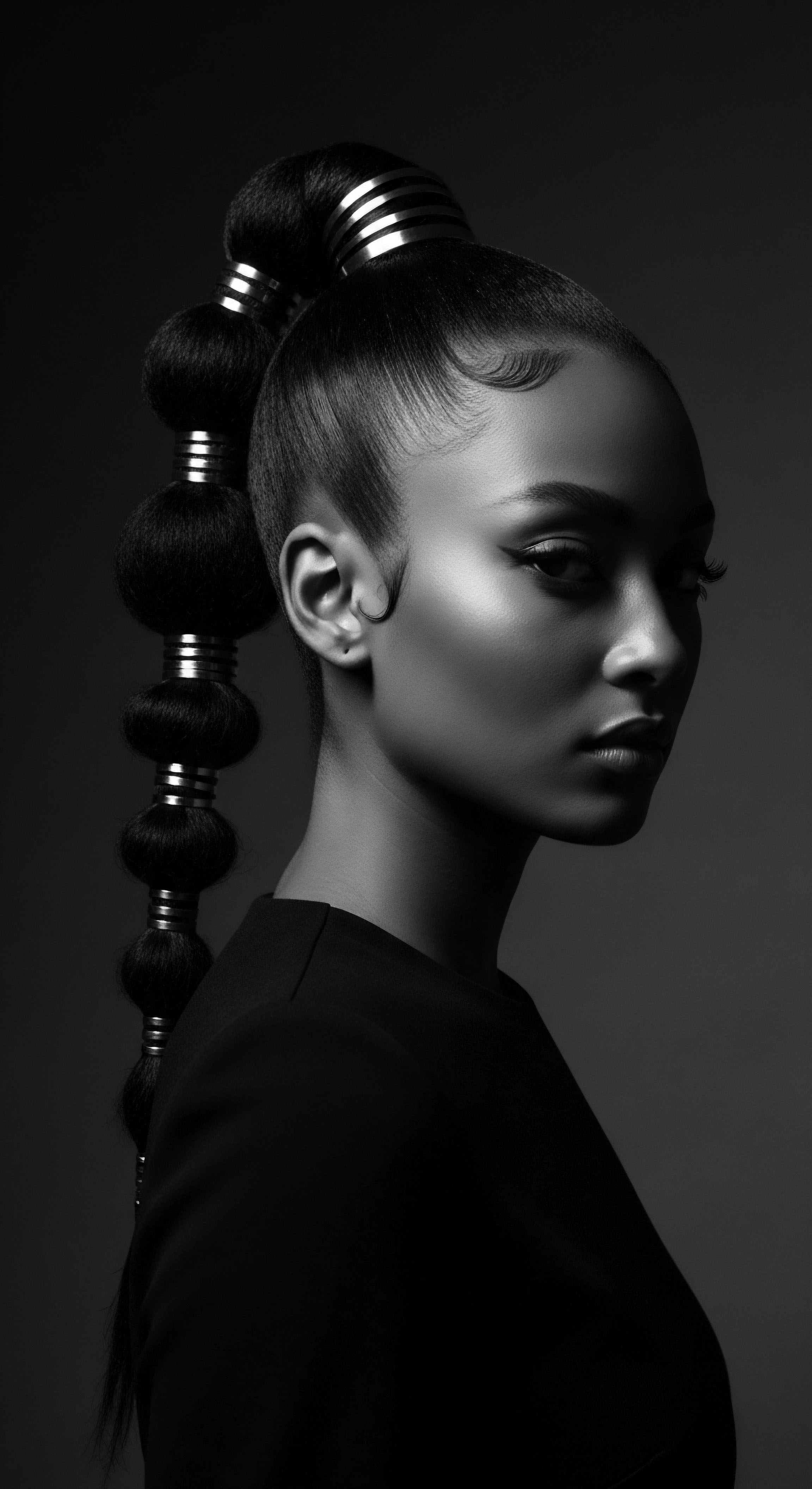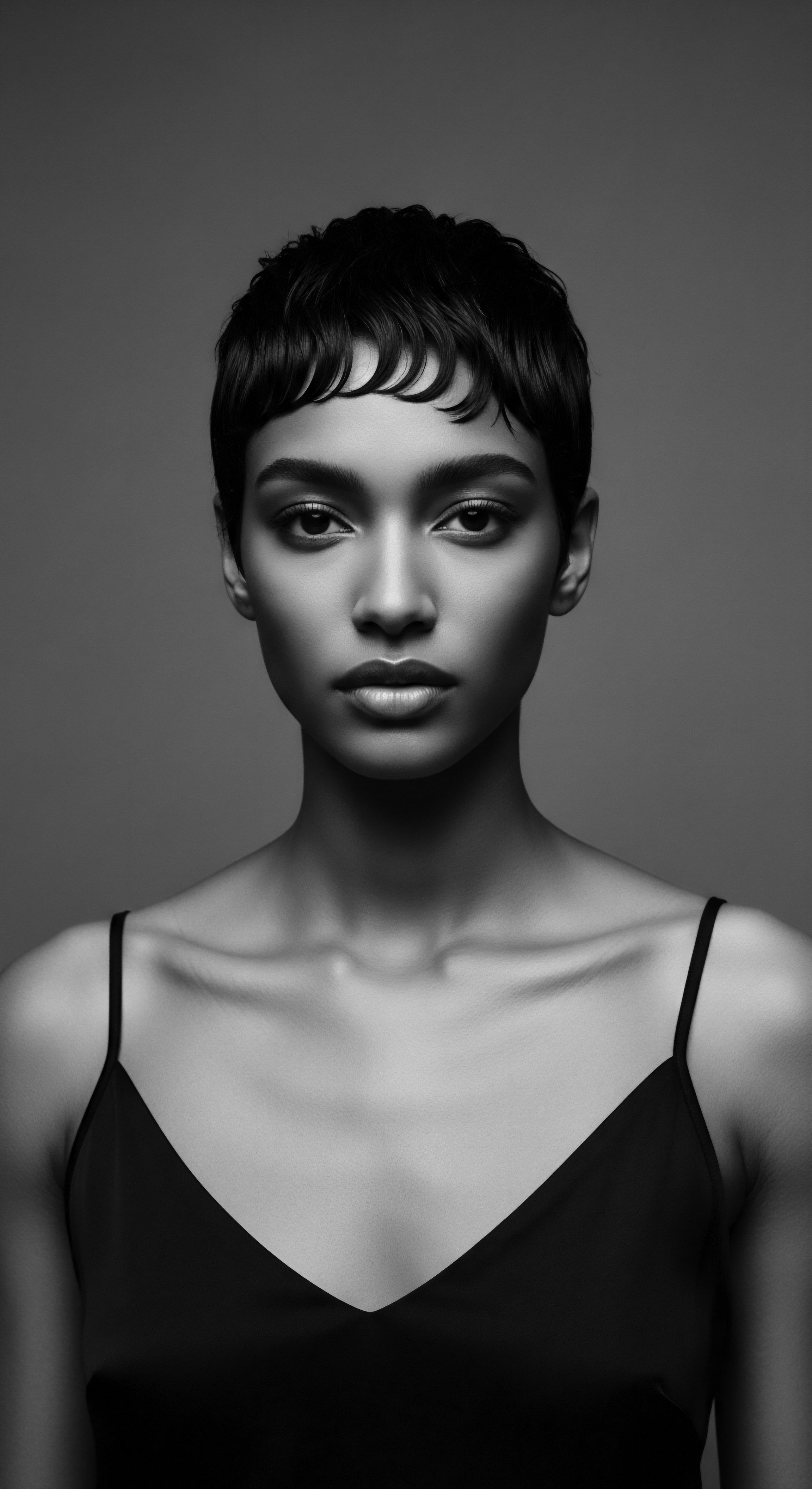The concept of “heritage” resonates deeply with the human experience, particularly when we speak of our physical attributes. Hair, a seemingly simple biological extension, carries within its structure tales of ancestry, movement, and survival. Textured hair, with its remarkable variations in curl, coil, and wave, stands as a living archive of human diaspora, a profound connection to generations past.
Its scientific underpinnings, when viewed through the lens of history and culture, reveal not only genetic marvels but also the enduring wisdom of those who understood its unique needs long before modern laboratories existed. Roothea understands this intimately, acknowledging that to truly comprehend textured hair genetics, we must first listen to the echoes of its beginnings, honoring the ancestral hands that have shaped its story.

Roots
The very architecture of textured hair, from its genesis within the scalp to the curl pattern it expresses, holds codes written across millennia. These codes speak of migrations, adaptations, and the diverse tapestry of human populations. When we consider the fundamental understanding of textured hair through a historical and scientific heritage perspective, we begin to appreciate the intricate dance between our ancient past and our present selves.

Hair Anatomy and Its Ancestral Blueprints
The journey of a single strand begins in the hair follicle, a microscopic organ beneath the skin. For textured hair, this follicle is often oval or elliptical in cross-section, leading to the characteristic coils and curves we recognize. This differs from the rounder follicles associated with straighter hair prevalent in other populations. Research indicates that the shape of the hair follicle dictates the hair’s curl.
A nearly flat, ribbon-like structure of the follicle generates very tightly coiled hair, a common trait in people of African ancestry. The angle at which the hair emerges from the scalp and the asymmetry within the follicle’s mitotic zone also play roles in determining curl.
Consider the structural integrity of these strands. African textured hair, for instance, exhibits a higher density of disulfide bonds, which contribute to its unique shape and resilience. However, these tight curls also create points of stress along the fiber, rendering the hair more susceptible to mechanical extension and breakage if not handled with knowing care. This particular biology underpins many traditional hair care practices developed over centuries, focused on moisture retention and gentle handling.
The shape of the hair follicle, a biological signature passed through generations, serves as a primary determinant of textured hair’s distinctive curl pattern.

Textured Hair Categories and Their Cultural Dimensions
Modern classification systems for textured hair, often denoted by numbers and letters (e.g. 3A, 4C), attempt to categorize the spectrum of curl and coil patterns. Yet, these systems, while useful for contemporary product selection, sometimes overlook the rich historical classifications and cultural significance that communities themselves developed. In pre-colonial African societies, hair texture and style were not merely aesthetic choices.
They served as a visual language, communicating a person’s tribe, social status, age, marital status, and even spiritual beliefs. Hair was a public, modifiable biological marker, deeply embedded with meaning.
- Kinky Coils ❉ In many West African cultures, tightly coiled patterns, sometimes called “kinky,” were celebrated for their density and unique lift. They could be shaped into elaborate sculptural forms that conveyed deep communal ties.
- Bantu Knots ❉ Traced back to the Bantu-speaking communities in Southern West Africa from the 2nd millennium BCE, these coiled styles held cultural significance as identity markers during migrations across the continent.
- Z-Shaped Curls ❉ These sharp, angular curl patterns are common in Type 4 hair and were often seen as symbols of strength and connection to the earth in various ancestral traditions.

Ancestral Genes and Adaptations
The genetic basis of hair texture is a subject of ongoing scientific inquiry. While certain genes, like EDAR and FGFR2, have been associated with hair thickness in Asian populations, and TCHH with hair texture in Northern European ancestry, the specific genes responsible for the variations observed in textured hair, particularly African hair, are still being fully mapped. Nonetheless, the consistent inheritance of textured hair across generations within African populations strongly points to its genetic origin.
Some researchers theorize that the unique characteristics of afro-textured hair, such as its often sparse density and tight coils, may have evolved as an adaptive response to tropical climates. This hair type could have provided protection from the sun’s UV rays while allowing for better scalp ventilation, aiding in thermoregulation in hot environments. This biological adaptation, honed over millennia, forms a core part of the genetic heritage of textured hair.
| Trait Follicle Shape |
| Ancestral Context Passed down through family lines, influencing regional hair traditions. |
| Current Scientific Understanding Oval or curvilinear, leading to the characteristic curl. |
| Trait Disulfide Bonds |
| Ancestral Context A biological signature supporting complex styling in various climates. |
| Current Scientific Understanding Higher density in African hair, contributing to its coiled structure. |
| Trait Moisture Retention |
| Ancestral Context Understood through centuries of natural product application. |
| Current Scientific Understanding Sebum does not distribute evenly along coiled strands, necessitating external moisturization. |
| Trait Our hair's inherent biology carries signatures of our origins, influencing both its behavior and the practices developed to care for it. |
The language we use to describe hair also carries historical weight. Terms like “good hair,” which in some Black communities has described straighter or loosely curled hair, reflect the historical pressures of Eurocentric beauty standards. Understanding the origins of such terms, contrasting them with pre-colonial African societies where textured hair was inherently valued, allows for a more informed and respectful lexicon around hair. The collective memory embedded in language shapes our perceptions, and by reclaiming a vocabulary rooted in appreciation for all textured hair forms, we honor its full genetic and cultural spectrum.

Ritual
The handling of textured hair has always been a ritual, a practice passed down through kin, shaping communal bonds and individual identity. These customs, far from being mere aesthetics, are often informed by an intuitive understanding of the hair’s unique genetics and structural needs. The styling techniques, the tools employed, and the transformations witnessed reflect a deep, inherited wisdom that predates modern cosmetology. These rituals connect us to ancestral ingenuity, showing how hair’s biological makeup influenced practices designed to protect and celebrate it.

Protective Styling Through Time
The concept of protective styling, so prevalent today in textured hair communities, holds ancient origins. Across Africa, styles like braids, twists, and cornrows were not solely decorative. They served practical purposes ❉ protecting the hair from environmental elements, minimizing manipulation, and preserving length. These practices were especially vital for hair types prone to breakage due to their unique coiled structure and slower growth rates compared to other hair types.
Consider the significance of cornrows. Dating back as far as 3000 B.C. in regions of Africa, these intricate patterns were used as a form of communication. During the Transatlantic slave trade, enslaved African women, particularly rice farmers, braided rice seeds into their cornrows as a means of survival and to preserve their homeland’s agricultural knowledge.
This historical example underscores how styling rituals were intertwined with survival, resistance, and the safeguarding of cultural heritage. The deliberate art of hair sectioning and plaiting, often a communal activity, reflects an understanding of how to manage the unique mechanical properties of coiled hair to prevent tangling and damage.

How Does Ancestral Wisdom Inform Styling Methods?
Ancestral wisdom often recognized that the inherent fragility of textured hair, stemming from its irregular cross-sectional shape and uneven distribution of cuticles, necessitated gentle methods. Practices like African threading, where hair is wrapped tightly with thread to stretch and straighten it without heat, demonstrate a clever approach to altering texture while preserving health. This method reduces the need for harsh chemicals or excessive heat, which can compromise the hair’s structural integrity, especially at the points of natural curl.
The application of natural oils and butters, common in many traditional African hair care practices, also speaks to an understanding of hair’s genetic requirements. As scientific studies have confirmed, the tight coiling of textured hair makes it difficult for natural sebum to travel down the hair shaft, leaving ends prone to dryness. Traditional remedies, such as shea butter, marula oil, and African black soap, address this inherent need for external moisture and lubrication, providing a historical basis for many contemporary conditioning practices.
Styling traditions are not mere adornments; they are codified responses to hair’s innate biology, passed down as a communal inheritance.

The Tools of Transformation ❉ Old and New
The tools used in textured hair styling also carry a lineage. While modern combs and brushes abound, traditional implements like wide-toothed combs, wooden picks, and natural fibers played a crucial role in detangling and shaping hair with minimal breakage. These tools, often crafted from natural materials, were designed to navigate the hair’s coiled architecture without causing undue stress on the strands or follicles. This mindful approach to tool selection is a testament to the practical understanding of hair’s fragility within ancestral communities.
- Wooden Combs ❉ Carved and smoothed to reduce snagging, these tools were designed to gently separate and style coiled hair, preserving its integrity.
- Gourd Bowls ❉ Used for mixing natural ingredients like clays and botanical infusions, highlighting the deep connection between hair care and natural resources.
- Natural Fibers and Threads ❉ Employed in African threading and wrapping techniques, offering methods to stretch and protect hair without reliance on heat.
| Traditional Practice Cornrows/Braids |
| Genetic/Structural Basis Understood Historically Protects fragile strands from daily manipulation; communal bonding. |
| Modern Parallel/Scientific Confirmation Reduces mechanical damage, length retention; acknowledged as protective styling. |
| Traditional Practice Oil/Butter Application |
| Genetic/Structural Basis Understood Historically Combats dryness, provides suppleness. |
| Modern Parallel/Scientific Confirmation Supplements uneven sebum distribution along coiled hair shaft. |
| Traditional Practice Headwraps/Coverings |
| Genetic/Structural Basis Understood Historically Shields hair from sun and elements; communicates status. |
| Modern Parallel/Scientific Confirmation Protects from environmental aggressors, reduces moisture loss. |
| Traditional Practice The ingenuity of ancestral hair practices demonstrates a profound understanding of textured hair's unique requirements, which modern science continues to affirm. |
Even the historical use of hair extensions and wigs, common across various African cultures long before contemporary trends, reflects an inventive approach to hair management. These additions could signify status, mourning, or transition, providing versatility while allowing natural hair to rest and grow. The understanding that hair, though culturally significant, could also be vulnerable, spurred generations to devise methods that honored its innate characteristics. The rituals of styling, therefore, are not separate from the biology of hair; they are its direct, lived response, a beautiful dialogue between genetic inheritance and human ingenuity.

Relay
The care of textured hair, often viewed as a daily routine, is in truth a relay race through time, carrying forward centuries of ancestral wisdom. It is a dialogue between the biological inheritance encoded in our genes and the cultural practices honed over generations. Understanding how heritage informs holistic care and problem-solving requires a deep dive into the interconnectedness of our physical selves, our communal knowledge, and the very ground from which our traditions sprung. Modern science, in many instances, is beginning to affirm the efficacy of these time-honored approaches, revealing a profound congruence between ancient practices and contemporary understanding of hair genetics.

Building Personalized Regimens Informed by Lineage
The concept of a personalized hair regimen is not new; it has been the bedrock of ancestral hair care for millennia. Communities understood that hair, while sharing common textured attributes, possessed individual variations. Herbalists and hair specialists within these societies crafted solutions tailored to specific needs, drawing from locally available botanicals and inherited knowledge. This ancestral wisdom often recognized the importance of balancing cleansing with moisturizing, acknowledging that tightly coiled hair is inherently drier due to the challenges sebum faces in traversing its helical structure.
A notable historical example of this individualized approach comes from the Basara Arab tribe of Chad. For centuries, the Basara women have used a meticulously prepared mixture known as “Chébé powder,” derived from local plants and spices. This powder, applied regularly and kept sealed by braiding, has been documented to contribute significantly to length retention and hair thickness among generations of women in the Basara community (Africa Imports, 2021).
This practice speaks to an ancient understanding of moisture retention and minimizing mechanical stress, practices that directly address the genetic predisposition of textured hair to dryness and breakage. The consistent application of such a regimen, informed by empirical observation over centuries, demonstrates a sophisticated, pre-scientific understanding of hair’s specific needs, passed down through matriarchal lines.

How Do Nighttime Rituals Protect Genetic Vulnerabilities?
The nighttime sanctuary, with its bonnets and wraps, is a testament to the practical application of ancestral foresight concerning hair health. Textured hair, particularly its finer variations, can be susceptible to damage from friction against abrasive surfaces like cotton pillowcases. This friction can lead to tangling, breakage, and moisture loss, exacerbating the inherent brittleness that stems from the hair’s coiled structure and its points of vulnerability.
The tradition of wrapping hair in soft cloths or using protective head coverings before sleep, prevalent in numerous African and diasporic cultures, directly addresses these vulnerabilities. These coverings create a protective barrier, reducing friction, preserving moisture, and maintaining styled hair. The historical prevalence of headwraps, initially worn for cultural identification and later sometimes forced as markers of subservience during slavery, transformed into symbols of quiet resistance and practical care for many. This ritual, whether a vibrant headwrap or a simple cloth, speaks to a deep, collective understanding of how to safeguard one’s hair through the hours of rest, ensuring its vitality for the waking world.
- Silk and Satin Wraps ❉ These modern materials replicate the soft, low-friction environment sought by ancestral coverings, minimizing cuticle damage.
- Protective Styles for Sleep ❉ Twists, braids, and pineapples keep hair contained, reducing tangles and preserving curl patterns.
- Restorative Treatments ❉ Overnight oiling or deep conditioning, a practice with ancient roots, works with the hair’s natural absorption to replenish moisture.

Ingredient Wisdom and Problem Solving
The ancestral pharmacopeia of textured hair care is vast, drawing from a profound connection to the natural world. Traditional ingredients were not chosen haphazardly; their efficacy was observed and passed down, often aligning with properties now recognized by modern biochemistry. The use of botanicals like aloe vera for soothing scalps, rhassoul clay for gentle cleansing without stripping natural oils, or various plant-based oils and butters for lubrication speaks to an intuitive, generational knowledge of hair’s needs.
For example, the presence of various natural oils, like shea butter and coconut oil, in traditional African hair care addresses the unique lipid distribution challenges in coiled hair. Sebum, the natural oil produced by the scalp, struggles to travel down the curves of textured hair, leaving the ends particularly dry. These ancestral applications compensated for this genetic characteristic, providing external lubrication to reduce breakage and maintain suppleness.
Similarly, the historical prevalence of certain alopecia types among African American women, such as traction alopecia or central centrifugal cicatricial alopecia (CCCA), linked to tight styling practices or harsh chemical relaxers, highlights the historical challenges and the ongoing need for protective, health-centered care. This recognition underscores the necessity of marrying genetic understanding with compassionate, heritage-informed care practices to address hair health challenges effectively.
| Hair Challenge Dryness/Brittleness |
| Ancestral Countermeasure/Insight Regular application of natural butters/oils; low-manipulation styling. |
| Modern Scientific Understanding/Solution Coiled structure impedes sebum distribution; external emollients are vital. |
| Hair Challenge Breakage |
| Ancestral Countermeasure/Insight Protective styles, gentle detangling with fingers/wide-tooth combs. |
| Modern Scientific Understanding/Solution Points of stress along the curl helix are vulnerable; minimized friction preserves integrity. |
| Hair Challenge Scalp Irritation |
| Ancestral Countermeasure/Insight Herbal rinses, clay washes, gentle cleansing agents. |
| Modern Scientific Understanding/Solution Focus on balanced pH and non-stripping ingredients for scalp health. |
| Hair Challenge Many modern hair care solutions echo the wisdom of ancestral practices, providing testament to a long-held understanding of textured hair's distinct requirements. |
The relay of care continues, a continuous exchange where modern dermatological and trichological research provides deeper scientific explanations for the phenomena observed and managed by our ancestors. This interconnectedness allows for problem-solving that is both scientifically sound and deeply respectful of the heritage that has shaped textured hair’s resilience and beauty.

Reflection
Our exploration of textured hair genetics through the heritage lens reveals a narrative richer and more intricate than any single scientific study could capture. It is a story told not only in DNA sequences and follicular shapes but also in the braided pathways of history, the protective embrace of ancient rituals, and the enduring spirit of communities. The very understanding of a strand of textured hair becomes a meditation on identity, survival, and the profound legacy passed down through time. To truly know textured hair is to honor the hands that tended it through generations, the wisdom that preserved it against colonial efforts, and the vibrant life it continues to embody today.
The ‘Soul of a Strand’ whispers of this continuum. It speaks of hair not as a mere adornment but as a living archive, each coil and curve holding echoes of journeys taken, knowledge gained, and a resilience that refused to be diminished. Our scientific inquiries into hair’s genetic code become more meaningful when paired with the cultural context that has celebrated and protected these unique attributes. This journey of understanding moves beyond simply classifying hair types; it asks us to recognize hair as a central character in the ongoing human narrative, particularly for those of African and mixed-race descent.
In this understanding, we find not a conclusion, but an invitation. An invitation to continue listening to the lessons of heritage, to respect the ingenuity of ancestral practices, and to allow both science and soul to guide our contemporary relationship with textured hair. It stands as a testament to the fact that while genes sculpt our physical forms, our collective heritage breathes life into their meaning, ensuring that the wisdom of the past guides our steps towards a future where every textured strand is seen for the deep, beautiful story it is.

References
- Oladele, D. Markiewicz, E. & Idowu, O. C. (2024). The Genomic Variation in Textured Hair ❉ Implications in Developing a Holistic Hair Care Routine. Preprints.org .
- The Tech Interactive. (2005). Why do people of African descent have a unique hair texture? The Tech Interactive .
- MedlinePlus. (2022). Is hair texture determined by genetics? MedlinePlus .
- BLAM UK CIC. (2022). The history of Black Hair. BLAM UK CIC .
- Oduol, E. (2018). Hair in African Art and Culture. ResearchGate .
- Johnson, A. D. (2023). What Every Dermatologist Must Know About the History of Black Hair. Clinics in Dermatology, 41 (6), 841-846.
- LivLoves. (2023). The Science Behind Curly Hair ❉ What Makes Curly Hair, Curly? LivLoves .
- Sellox Blog. (2021). Ancient African Hair Growth Secrets For Healthy Hair. Sellox Blog .
- Wikipedia. (n.d.). Hair follicle. Wikipedia .
- Pereira, C. (2024). Hair as Freedom. BUALA .
- Wikipedia. (n.d.). African-American hair. Wikipedia .
- Khumalo, N. P. et al. (2021). The Biology and Genetics of Curly Hair. ResearchGate .
- Miteva, M. & Tosti, A. (2019). Hair Aging in Different Races and Ethnicities. The Journal of Clinical and Aesthetic Dermatology, 12 (1), 28–34.
- JSTOR Daily. (2018). Why Do Some People Have Curly Hair and Others Straight? JSTOR Daily .
- Africa Imports. (n.d.). Traditional African Secrets For Long And Healthy Hair. Africa Imports .
- Bebrų Kosmetika. (2024). The Power of Hair in African Folklore ❉ Rituals and Traditions. Bebrų Kosmetika .
- Teka, D. Z. et al. (2025). Plants used for hair and skin health care by local communities of Afar, Northeastern Ethiopia. Ethnobotany Research and Applications, 29, 1-13.
- Miteva, M. & Tosti, A. (2013). Hair Care Practices in African-American Patients. Seminars in Cutaneous Medicine and Surgery, 32 (3), 103-108.
